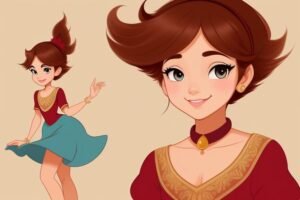animation techniques
Animation techniques are the various methods and processes used to create the illusion of movement and change in a series of images or frames. Animation is a visual art form that involves bringing still images, objects, or characters to life through a sequence of rapidly displayed frames. These techniques have evolved significantly over time, from traditional hand-drawn animation to modern computer-generated animation. Here are some of the most common animation techniques:
- Traditional (Hand-Drawn) Animation:
- Traditional animation involves creating each frame of animation by hand, typically on sheets of paper or cels (transparent sheets).
- Animators draw each frame, making slight changes to create the illusion of movement when the frames are played in sequence.
- Classic examples of traditional animation include Disney’s early animated films like “Snow White” and “Cinderella.”
- 2D Computer Animation:
- 2D computer animation involves creating animation using digital software, often by drawing and manipulating digital characters and objects.
- It is a more efficient and versatile method compared to traditional hand-drawn animation.
- 2D computer animation is used in various forms, including television shows, web animations, and video games.
- Stop-Motion Animation:
- Stop-motion animation involves capturing a series of still photographs of physical objects, puppets, or models in various positions.
- Animators make small adjustments to the objects between each frame, creating the illusion of movement when the frames are played in sequence.
- Well-known examples of stop-motion animation include “Wallace and Gromit” and “The Nightmare Before Christmas.”
- 3D Computer Animation:
- 3D computer animation involves creating characters, objects, and scenes in a three-dimensional digital environment.
- Animators manipulate these digital elements to create movement and animation.
- 3D computer animation is widely used in feature films, video games, and commercials and has been made popular by studios like Pixar and DreamWorks Animation.
- Claymation:
- Claymation is a form of stop-motion animation that uses clay or plasticine figures and characters.
- Animators sculpt and pose these figures, taking photographs of each pose to create the animation.
- The “Wallace and Gromit” series is a famous example of claymation.
- Cutout Animation:
- Cutout animation involves using two-dimensional characters and objects cut from materials like paper, cardboard, or fabric.
- These cutout elements are then manipulated and photographed frame by frame to create animation.
- The technique is often used in educational videos and children’s programming.
- Motion Capture (MoCap):
- Motion capture involves recording the movements of real-life actors or objects and applying those movements to digital characters.
- MoCap is commonly used in video games and visual effects in films to create realistic character animations.
- Rotoscoping:
- Rotoscoping involves tracing over live-action footage frame by frame to create animated sequences.
- It can be used to combine live-action and animation seamlessly, as seen in films like “A Scanner Darkly.”
- Hybrid Animation:
- Hybrid animation combines different animation techniques to achieve specific artistic or storytelling goals.
- For example, a film may use a combination of 3D computer-generated characters in a live-action environment.
These animation techniques are constantly evolving with advancements in technology, giving animators and filmmakers more creative options and flexibility in bringing their visions to life. The choice of technique depends on the project’s requirements, artistic style, and intended audience.




